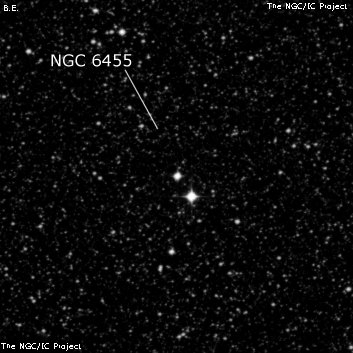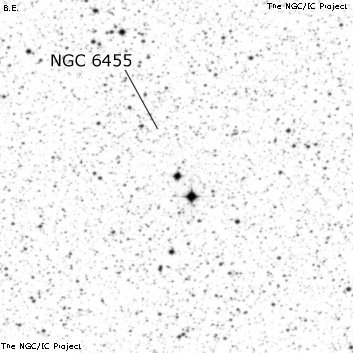NGC/IC Project Restoration Effort
(This is a very very beta version)
NGC6455


Basic Information
Location and Magnitude
Right Ascension: 17:51:8.0
Declination: -35:20:14
Constellation: SCO
Visual Magnitude:
Historic Information
Discoverer: Herschel J.
Year of discovery: 1837
Discovery aperture: 18.3
Observational
Summary description: Cl, rr, st eS + neb
Sub-type: *Cloud
Corwin's Notes
=====
NGC 6455 may be the random clumping of Milky Way stars around HD 320780 = SAO
209348 (this is about 50 seconds preceding JH's approximate position, and is
the fainter of two bright stars. The other is HD 162145.) JH, however, does
not mention the bright stars. His published description reads, "A very
extensive nebulous clustering mass of the milky way [sic]. The stars [are] of
excessive smallness, and infinite in number."
The sweep shows us that JH estimated the RA to just a full minute of time, and
the NPD to a minute of arc; he recorded no seconds of time or arc. JH does
add a bit to the description, saying "Another very extensive nebulous
clus[ter] [containing?] stars of exceptional smallness and infinite in number,
and all having an alteration of vacuity and [illegible] mass [?] surprising
and baffling all description." (The writing in the sweep is hard to make out,
so I would not be surprised if some of my decyphering of it is wrong.) JH's
approximate position in fact falls in one of the "vacuities".
ESO chooses a "concentration of stars" (not obvious to me) near JH's
position, and Wolfgang Steinicke takes a small asterism of faint stars at
17 49.0 -35 27. I doubt that either of these could be JH's object.
Coming back to this in January 2016, I see a poorly-defined star cloud about
20 arcmin by 13 arcmin across, located a minute west and four arcminutes south
of JH's estimated place. Earlier I had chosen the same "object", but placed
the center about 7 arcminutes north. I'm unsure about this identification, of
course, so have marked it with colons in the table. All this shows just how
subtle JH's object is, indeed "baffling all description".
This is another case where a visual observation would be useful.
Steve's Notes
=====
NGC 6455
24" (7/7/13): at 125x (50' field), this position corresponds with a very large, bright Milky Way field just southwest of M7. The field includes a nice mix of mag 7 and fainter stars centered near a bright, very wide pair (mag 7 HD 162145 and mag 8.5 HD 320780). The Milky Way background here is glowing, but the field itself is not special considering the region, and it certainly does not appear cluster-like.



